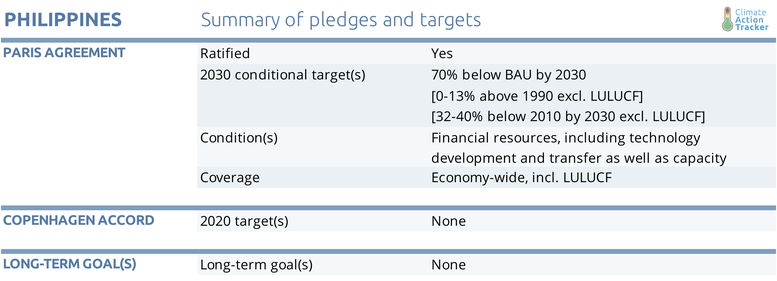Pledges And Targets
Summary Table

Paris Agreement targets
The Philippines’ Nationally Determined Contribution (NDC) is a 70% reduction in GHG emissions below BAU projections by 2030, condition on financial, technological and capacity building support (Government of The Philippines, 2015).
The NDC target does not distinguish LULUCF emissions reductions from the reductions in other sectors and lacks a BAU scenario emissions projections used to quantify the NDC target. The BAU is based on projections developed by the CAT in 2015 since it represents a pathway built with information available during the formulation of the NDC (see Assumptions). If we apply the 70% emissions reductions target to non-LULUCF emissions, the NDC could result in emissions decreasing below 2010 levels (excluding LULUCF) by 2030. If the government expects larger carbon sinks from LULUCF than in our analysis, other sectors would have to decarbonise less to achieve the emissions reduction target.
The need for a transformation in all sectors is recognised in the NDC as it states that the Philippines “views the need to peak its emissions as an opportunity to transition as early as it can to an efficient, resilient, adaptive, sustainable clean energy-driven economy, and it is determined to do so with partners from the global community.” Presenting which portion of the commitment should be met by the LULUCF sector and which portion from other sectors would be in line with the mentioned transformation and peaking.
The Philippines’ Climate Change Commission is in the process of revising its NDC, and has proposed a tentative NDC that makes progress in defining mitigation strategies and targets for all sectors. The tentative NDC revises the conditional target from 70% to 67% below BAU by 2030 (Climate Change Commission, 2017), a weakening of its level of ambition if based on the same BAU. The draft also presents sectoral reductions but not sector BAU projections making it difficult to quantify the emissions reductions contributions and evaluate the ambition level.
Further analysis
Latest publications
Stay informed
Subscribe to our newsletter




